Panel 1
Francesca Giaime, Stefano Pranzo, Valentina Sini
The indicator provides an overview of the regional planning in force relating to seven types of plan and the state of application of the related Strategic Environmental Assessment (SEA) processes. As of December 31, 2024, 130 floors have been completed out of a total of 147 planned floors, for a coverage of 88%. In the same period, the total number of complete plans in force with SEA rose to 105, which represents 71% of all complete plans envisaged (147) and 81% of the plans currently complete (130).
The indicator provides information on the regional planning framework in place for seven types of plans established by national legislation. The choice of the types of plans monitored is based on their strategic nature for the implementation of environmental and territorial development policies. These are also plans whose implementation can have significant effects on the environment, so they must be subject to SEA pursuant to Legislative Decree 152/2006 and subsequent amendments.
To provide as significant knowledge as possible on the state of the regional planning process and the related SEA processes. This allows to have an updated picture of the planning actions that give integrated responses to environmental and territorial pressures, and therefore also to provide a contribution to the "external coherence analysis" of SEA processes. In addition, it makes it possible to verify how sustainable development guidelines are implemented through the integration of the SEA into specific plans.
Legislative Decree 152/2006 and subsequent amendments and additions.
Regional laws relating to the SEA.
Legislative Decree 152/2006 as amended. regulates the process of applying the SEA to plans and programmes that are likely to have significant effects on the environment and cultural heritage. The regional plans taken into consideration belong to sectors that must be systematically subject to SEA. These plans are established by national legislative provisions in the sector, shown in Table A.
The plans referred to in Table A must therefore be drawn up and must be subject to SEA.
Panel 2
ISPRA, Yearbook of environmental data, various years
Institutional websites of the MASE, the MiC, the Regions and Autonomous Provinces, the ARPA/APPA
http://www.leggiditaliaprofessionale.it
http:// www.gazzettaufficiale.it/
Data quality assessment
ISPRA/ARPA/APPA
Ministry of the Environment and Energy Security (MASE)
Ministry of Culture (MiC)
Autonomous Provinces
Regions
Search for information relating to planning processes and related SEA through the main search engines and in particular through the websites of: - MASE - MiC - Regions - Autonomous Provinces - ARPA/APPA
Regional/Autonomous Province
2010-2024
Indicator assessment
Elaboration and systematization in tables and maps of the data and information collected regarding some types of regional plans and the related SEA processes carried out in implementation of the provisions of Legislative Decree 152/06 and subsequent amendments. or other regulatory references (EU Directive 42/2001, the related regional laws, etc.).
- summation (total and by type) of the complete and current plans (table and geographical representation)
- summation (total and by type) of the plans completed in the reference year (table) - summation (total and by type) of the plans updated and/or modified in the reference year (table)
- percentage ratio (total and by type) between the sums of the complete and current plans and the maximum possible number of complete and current plans (table)
- summation (total and by type of plan) of the SEA processes in progress (table)
- summation (total and by type of plan) of SEA processes concluded in the reference year (table)
- summation (total and by type) of the complete plans in force with the SEA process (table and geographical representation)
- total percentage ratio, by type and by region/autonomous province, between the sums of the complete plans in force with SEA and the maximum possible number of complete plans in force (table)
- percentage ratio (total and by type) between the sums of the complete plans in force with SEA and the sums of the complete plans in force (table)
In general, in 2024, there is a high number of complete plans: 130 out of 147 planned (88%). Specifically, energy, waste management and water protection (21 out of 21) stand out, while for the other types of plan the level of response is lower (14-19 out of 21). Compared to the previous year, there is a slight progress: during 2024, 2 plans were completed and 9 plans underwent changes and/or updates (Table 1).
The situation of complete plans with SEA reflects that of planning: plans with SEA increased by 2 units compared to the previous year, reaching 105 units. The highest number of complete processes with SEA is confirmed among waste management plans (20) and energy plans (18), similarly to the planning situation, as well as for air quality remediation plans (18); while for the other types of plans the level of response remains lower (7-17). As of December 31, 2024, however, there were 42 SEA processes in progress, indicating intense planning activity, both new and updating, in progress (Table 2).
Planning/programming activities are by their nature subject to periodic updating/revision processes, also in consideration of the evolution of the legislation. The Strategic Environmental Assessment accompanies these processes. Over the years, it has been possible to observe a progressive process of adaptation to the regulations in force which, once fully operational, will settle at the maximum value of the planning processes and related SEA (147). The trend can be defined as positive for both processes (planning and SEA): between 2010 and 2024, planning grew by 36.8%, with coverage settling at 88%, while the Strategic Environmental Assessment increased more than four times (Figure 2).
Data
Table 1:: Current regional planning (31 December 2024)
ISPRA processing on data from regions and autonomous provinces
Table 2: Regional planning processes with SEA (31 December 2024)
ISPRA processing on data from regions and autonomous provinces
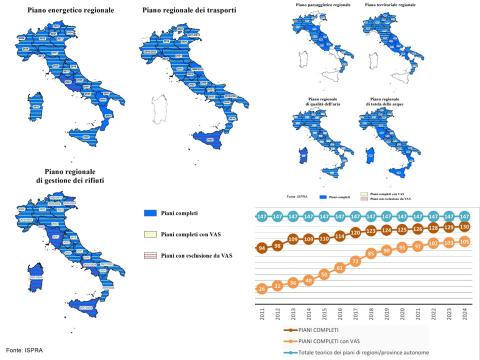
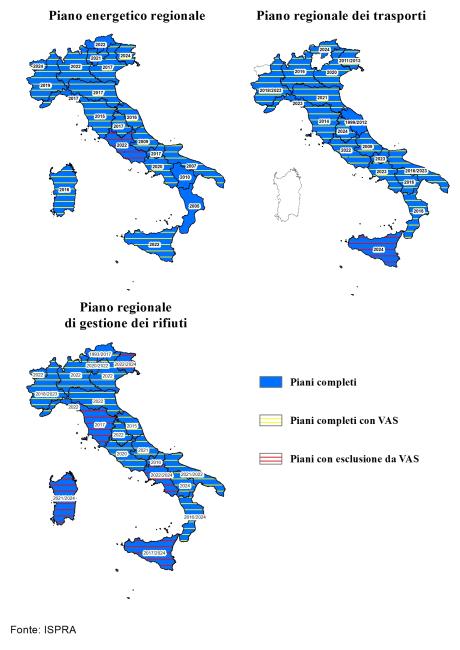
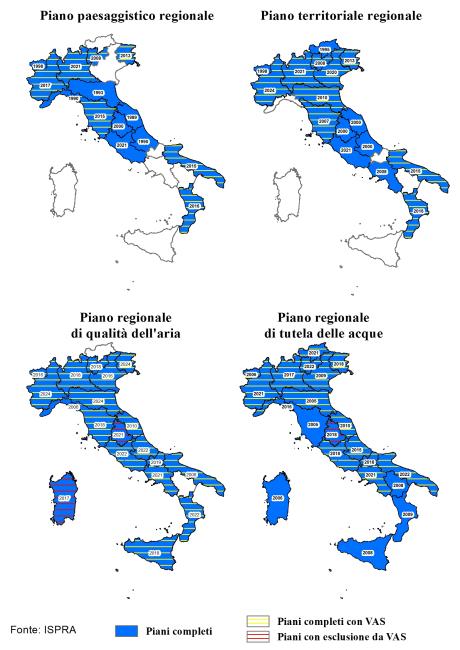
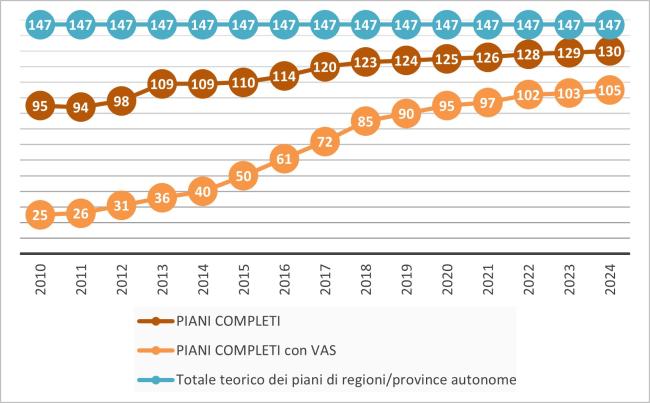
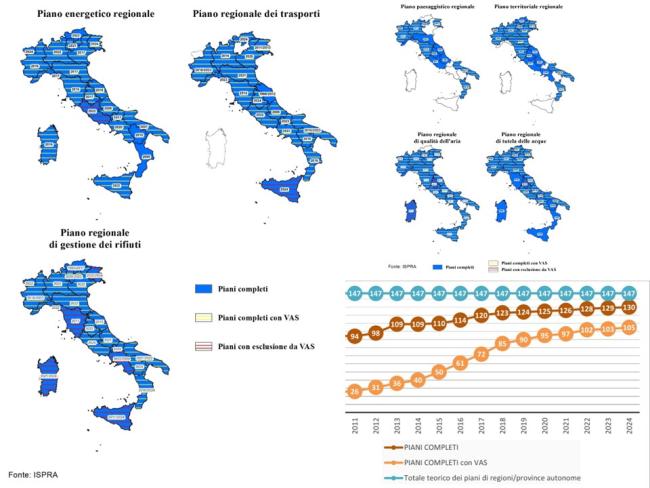
Table 1 shows the status of the schedule, whether or not it is complete. Also included are the main partial plans (by sector). A plan is considered complete when all the plans or partial excerpts that may compose it are present, except in cases where the planning tools in force are not updated with respect to current legislation. Only complete plans are counted in totals, not partial instruments. For those regions in which the territorial plan or the landscape plan take on both values, they are counted separately, i.e. as two plans, one territorial and one landscape.
As can be seen from Table 1 and Figures 1a and 1b, 11 regions are confirmed in which all the plans examined are in force and complete, specifically: Piedmont, Lombardy, Friuli-Venezia Giulia, Emilia-Romagna, Tuscany, Umbria, Marche, Lazio, Abruzzo, Puglia and Calabria. In 2024, 2 floors were completed and 9 floors underwent changes and/or upgrades. The total number of plans in force rises to 130, or 88% of the total expected (147).
As regards planning processes with SEA (Table 2), as of 2024 there are 105 complete plans with SEA (whose type and geographical distribution are represented in Figures 1a and 1b) and as many as 42 processes in progress. There are as many as 16 planning processes with SEA that have been completed in 2024: 2 for energy plans, 4 for transport plans, 6 for waste management plans, 1 for territorial plans and 3 for air quality remediation plans. The total number of comprehensive plans in force with SEA currently represents 71% of all comprehensive plans envisaged (147) and 81% of the plans currently in force (130). In this case, waste management plans are distinguished on the one hand (20 out of 21, about 95%), on the other hand there are landscape plans (with only 7 plans, about 33%). From an analysis by region, Piedmont, Lombardy, the Province of Trento, Veneto, Friuli-Venezia Giulia, Emilia-Romagna, Tuscany and Puglia are confirmed as those with the highest number of complete plans with SEA compared to the planned plans (86-100%), while Basilicata and the province of Bolzano are those with the lowest number (29%). Table 2 considers the different situations encountered on planning processes with SEA, including also partial plans and some special cases. The SEA processes indicated are intended to be in implementation of the provisions of Legislative Decree 152/06 and subsequent amendments. or other regulatory references (EU Directive 42/2001, the related regional laws, etc.). In this table, the expression "development of a new plan" is used both in the case of partial updating of the contents of an already approved plan (by extension, integration, adaptation, variation, etc.) and when the planning largely changes its specific objectives and contents, for example to comply with a radically new current legislation, or due to the change of direction of the executive body of the administration, or because a long time has elapsed without changes to the previous plan, it is necessary to restart the planning completely. As already done in the previous edition, proceedings initiated for more than eight years (reported in the note) and for which no further updates are available on the net are considered suspended. As regards the phases of the planning processes with SEA, an attempt was made to reduce the various situations encountered to three categories: elaboration of the new plan, complete plan (with act of approval or adoption), SEA monitoring on the plan being implemented. For monitoring, the year of the most recent information available is reported in brackets. For partial plans, the specific sectors to which they refer are reported in brackets. It was decided to include among the planning processes with SEA also those that provide for checks on the subjection of the full or partial content of the plan to SEA.